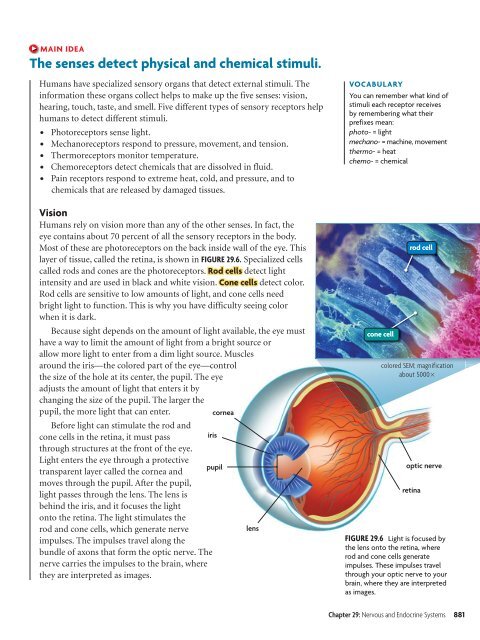Create successful ePaper yourself
Turn your PDF publications into a flip-book with our unique Google optimized e-Paper software.
MAIN IDEAThe senses detect physical <strong>and</strong> chemical stimuli.Humans have specialized sensory organs that detect external stimuli. Theinformation these organs collect helps to make up the five senses: vision,hearing, touch, taste, <strong>and</strong> smell. Five different types of sensory receptors helphumans to detect different stimuli.• Photoreceptors sense light.• Mechanoreceptors respond to pressure, movement, <strong>and</strong> tension.• Thermoreceptors monitor temperature.• Chemoreceptors detect chemicals that are dissolved in fluid.• Pain receptors respond to extreme heat, cold, <strong>and</strong> pressure, <strong>and</strong> tochemicals that are released by damaged tissues.VisionHumans rely on vision more than any of the other senses. In fact, theeye contains about 70 percent of all the sensory receptors in the body.Most of these are photoreceptors on the back inside wall of the eye. Thislayer of tissue, called the retina, is shown in FIGURE 29.6. Specialized cellscalled rods <strong>and</strong> cones are the photoreceptors. Rod cells detect lightintensity <strong>and</strong> are used in black <strong>and</strong> white vision. Cone cells detect color.Rod cells are sensitive to low amounts of light, <strong>and</strong> cone cells needbright light to function. This is why you have difficulty seeing colorwhen it is dark.Because sight depends on the amount of light available, the eye musthave a way to limit the amount of light from a bright source orallow more light to enter from a dim light source. Musclesaround the iris—the colored part of the eye—controlthe size of the hole at its center, the pupil. The eyeadjusts the amount of light that enters it bychanging the size of the pupil. The larger thepupil, the more light that can enter.corneaBefore light can stimulate the rod <strong>and</strong>cone cells in the retina, it must passiristhrough structures at the front of the eye.Light enters the eye through a protectivepupiltransparent layer called the cornea <strong>and</strong>moves through the pupil. After the pupil,light passes through the lens. The lens isbehind the iris, <strong>and</strong> it focuses the lightonto the retina. The light stimulates therod <strong>and</strong> cone cells, which generate nerveimpulses. The impulses travel along thebundle of axons that form the optic nerve. Thenerve carries the impulses to the brain, wherethey are interpreted as images.lensVOCABULARYYou can remember what kind ofstimuli each receptor receivesby remembering what theirprefixes mean:photo- = lightmechano- = machine, movementthermo- = heatchemo- = chemicalcone cellrod cellcolored SEM; magnificationabout 5000optic nerveretinaFIGURE 29.6 Light is focused bythe lens onto the retina, whererod <strong>and</strong> cone cells generateimpulses. These impulses travelthrough your optic nerve to yourbrain, where they are interpretedas images.Chapter 29: <strong>Nervous</strong> <strong>and</strong> <strong>Endocrine</strong> <strong>Systems</strong> 881
















